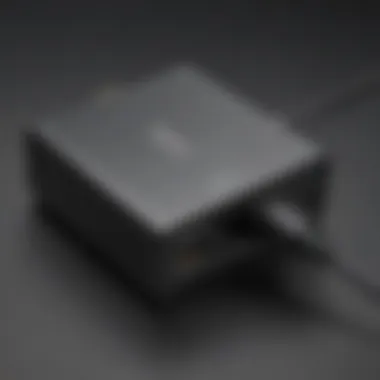Understanding USB PD PPS Chargers: A Comprehensive Guide


Intro
In our current digital age, the demand for efficient charging solutions has never been more pronounced. With the proliferation of devices that require timely and reliable power, understanding USB Power Delivery (PD) and Programmable Power Supply (PPS) chargers is crucial. These technologies not only promise faster charging times but also allow for dynamic power regulation, enhancing device longevity and user satisfaction.
As mobile devices become more sophisticated, the need for adaptable charging solutions grows. USB PD and PPS chargers represent a leap forward in this regard, offering notable advancements over traditional charging methods. This guide aims to shed light on the intricate workings of these charging technologies, providing insights into their development, practical applications, and the broader implications of adopting such technologies in everyday life.
By the end of this article, readers will gain a thorough understanding of USB PD and PPS, including their technical specifications, advantages, and potential challenges. Whether you are a tech enthusiast or a professional in the field, this exploration will equip you with the knowledge required to navigate the evolving landscape of charging solutions.
Prolusion to USB PD and PPS
The introduction of USB Power Delivery (PD) and Programmable Power Supply (PPS) represents a significant advancement in charging technology. These systems enhance the charging process by allowing for more efficient and flexible power transfer, which is crucial in an age where multiple devices demand efficient charging solutions. This section provides clarity on these concepts, highlighting their relevance in our increasingly tech-centric lives.
Definition and Origins
USB Power Delivery is a smart charging standard that allows devices to negotiate power requirements and manage power levels intelligently. Initially introduced as part of the USB 3.1 specification, USB PD aims to deliver more power than traditional USB standards. Meanwhile, Programmable Power Supply introduces a feature where the charger can dynamically adjust voltage and current based on the device's needs.
Origins trace back to a demand for faster and more efficient charging methods. Traditional USB charging could often be slow and inefficient, especially with the advent of high-capacity devices. USB PD emerged as a necessary evolution, enabling faster charging times and compatibility across various devices. The introduction of PPS complements this by allowing for even greater flexibility in charging protocols, adapting to the specific requirements of different devices, thereby preventing potential damage or inefficiency.
Relevance in Modern Technology
As technology advances, the need for efficient charging solutions has become increasingly prominent. Devices such as smartphones, tablets, and laptops now require more power compared to earlier models. USB PD and PPS address this by providing solutions that are not only faster but also safer.
- Efficiency: The ability of USB PD to negotiate power levels results in optimized charging cycles, reducing wait time for users.
- Versatility: These standard can charge multiple device types, from a small smartphone to a larger laptop, making them practical for everyday use.
- Safety Features: With integrated safety protocols, they help prevent overheating and overcharging.
"The adoption of USB PD and PPS underlines a significant shift towards adaptable, efficient charging solutions that cater to the requirements of modern technology."
In summary, the importance of USB PD and PPS in current technology cannot be understated. They address existing shortcomings in traditional charging methods by focusing on speed, efficiency, and safety. As our devices continue to evolve, so too must our approaches to power delivery.
The Technical Architecture of USB PD
The architecture of USB Power Delivery (USB PD) is complex but essential for understanding how modern charging solutions work. USB PD significantly enhances the power transfer capability over previous USB specifications and allows for more power-intensive devices to charge safely and efficiently. The advantages of this architecture lie in its ability to manage higher voltages and current flows, providing versatility in charging scenarios that previous technologies could not offer.
Power Delivery Basics
USB PD enables higher power levels through a system that allows devices to negotiate how much power they will draw. The technology supports power delivery up to 100 watts. This is more than enough to charge larger devices such as laptops and other high-performance gadgets.
Key elements of USB PD include:
- Role of Power Rules: USB PD defines specific roles among devices—power source and power sink.
- Adjustable Voltage Levels: Unlike traditional USB standards, which offer fixed voltages, USB PD allows for varying voltage levels; typically 5V, 9V, 15V, and 20V.
- Flexible Current Delivery: Connecting devices can communicate their current requirements, ensuring they receive the correct amount of power.
With these mechanisms, USB PD provides a dynamic, intelligent charging experience that adapts to the needs of connected devices.
Communication Protocols
The communication protocols utilized in USB PD play a vital role in how devices exchange information about their power needs. USB PD employs a specialized protocol known as Type-C Connection (USB-C) using the CC (Configuration Channel) pins. It utilizes the Device Communication Protocol (DCP) to facilitate communication between chargers and devices.
Some important aspects include:
- Role of CC Pins: The USB-C connector has two CC pins. These are crucial for determining cable orientation and device roles.
- Message Types: USB PD messages include Request, Response, and Status messages which help negotiate voltage, current, and other vital parameters.
These protocols ensure devices can communicate efficiently, leading to safer and faster charging processes.


Charging Profiles and Profiles Negotiation
Charging profiles are an essential component of USB PD. They are predefined power levels that devices can request. The profiles define how much power each device can safely consume. Through profiles negotiation, devices can agree upon a mutual charging plan based on their capabilities.
Important details regarding profiles include:
- Predefined Profiles: USB PD has specific profiles, like Profile 0 through Profile 5, which indicate different current and voltage levels.
- Negotiation Process: When two devices are connected, they exchange information about their supported power levels using the communication protocols.
- Smart Adjustments: If a device changes its state—increased usage or power-saving mode—the charging levels can adjust accordingly, ensuring optimal performance.
Exploring Programmable Power Supply (PPS)
The Programmable Power Supply (PPS) is a significant advancement in the landscape of USB charging technologies, particularly within the realm of USB Power Delivery (USB PD). Its purpose is to enhance the flexibility and efficiency of power delivery across various devices. The ability to monitor and adjust voltage and current dynamically introduces new possibilities for optimizing charging times and ensuring device safety. This section will dissect the functionality of PPS and its dual capability for adjusting voltages and currents according to the needs of connected devices.
PPS Functionality
At its core, PPS functionality revolves around two main components: communication and adaptation. It operates by establishing a two-way communication link between the charger and the device being charged. This interaction enables the charger to assess the requirements of the device in real-time. For instance, when a smartphone is connected, the PPS-enabled charger can adjust the output based on the battery's state of charge and temperature.
PPS opens the door for more efficient charging strategies. By allowing chargers to send precise amounts of power tailored to the needs of each device, it minimizes energy waste. When a lightweight portable charger is used for various devices, PPS might adjust the output down to a minimal requirement for small devices or ramp up greatly for larger ones. This essentially elevates the user experience while ensuring the longevity of battery life by carefully regulating the power flowing into the device.
Moreover, a key feature of PPS is that it supports a broad range of power levels. The chargers can deliver power from 3W to 100W, depending on device needs. This flexibility is crucial for the modern ecosystem where multiple devices have varying power requirements.
Dynamic Voltage and Current Adjustment
Dynamic adjustment of voltage and current stands as one of the most potent features of PPS. Unlike traditional fixed-voltage chargers, a PPS charger can adapt the output voltage and current on-the-fly. This means that as a device charges, it no longer needs to follow a static charging profile which might lead to either slow charging or potential overloading.
For instance, suppose a device is consuming power efficiently at a lower rate at the start of the charging cycle. Under PPS, the charger can modulate the output, beginning with a lower voltage. As the battery fills up and the charging properties change, the charger can elevate the voltage incrementally without human intervention. This not only ensures rapid charging but also enhances safety. Here, overcurrent and overvoltage scenarios are effectively managed to protect both the charger and the device.
"The dynamic adjustment capability of PPS allows for an intelligent charging experience unlike any previous standard."
This process is beneficial in preserving the health of lithium-ion batteries which are susceptible to degradation under unsuitable charging conditions. Additionally, it accommodates a range of devices from smartphones to laptops effectively, making it an invaluable tool for users with diverse technological needs.
Advantages of USB PD and PPS Chargers
In the realm of modern technology, USB Power Delivery (PD) and Programmable Power Supply (PPS) chargers have emerged as significant advancements in charging efficiency and compatibility. The adoption of these technologies brings about several crucial benefits that enhance the user experience and extend the functionality of a wide range of devices. Understanding these advantages is essential, especially for those who frequently invest in various electronic gadgets.
Increased Charging Speed
One of the principal advantages of USB PD and PPS chargers is their ability to deliver increased charging speeds. Traditional charging methods often restrict the power throughput, resulting in longer charging times. USB PD, however, allows devices to draw more power, reaching up to 100 watts in optimal conditions.
This enhanced speed is particularly noticeable with high-demand devices such as laptops or tablets. For example, a device like the MacBook Air can charge significantly faster when connected to a USB PD charger compared to standard USB chargers. Users can spend less time tethered to charging cables and more time using their devices. As more manufacturers adopt this standard, the convenience and speed of charging are likely to improve even further.
Versatility and Compatibility
USB PD and PPS chargers stand out in their versatility and compatibility across a wide array of devices. Unlike traditional chargers designed for specific devices, these chargers are capable of supporting various types of electronics, from smartphones to drones. This adaptability stems from the universal nature of the USB format, which is increasingly becoming the go-to solution for charging.
Many modern devices, including the Samsung Galaxy series or the Google Pixel, come equipped with USB PD capabilities. This means a user can charge multiple devices with a single charger, streamlining their charging routine and reducing the need for multiple power adapters. Consumers often prefer devices that utilize this technology due to its convenience, making it a preferred choice in today's market.
Enhanced Protection Features
Safety is paramount in charging technology, and USB PD and PPS chargers excel in this regard by incorporating robust protection features. These chargers are equipped with mechanisms such as overcurrent protection, overvoltage protection, and temperature control. Such features mitigate risks associated with overheating and short circuits, offering peace of mind during charging sessions.
For instance, if a device attempts to draw too much current, the charger can instantly adjust the power output or cut off power to prevent damage. Devices like the Dell XPS 13 leverage these safety features as part of their charging solutions, ensuring user safety and prolonging the lifespan of both devices and chargers. With the rising dependency on electronic devices, the significance of these safety features cannot be overstated.


"The rise of USB PD and PPS technology signals a shift towards safer, faster, and more efficient charging solutions, which is crucial in our device-centric lifestyles."
Compatibility Considerations
Understanding compatibility is a crucial aspect when dealing with USB PD and PPS chargers. As charging technology evolves, various devices require different power specifications and standards. Ensuring that your charger matches the specifications of your devices can lead to more efficient charging and prevent potential damage.
Devices Supporting USB PD and PPS
Many modern devices are designed to support USB PD and PPS technologies. Notable examples include:
- Smartphones: Most flagship models from brands like Apple, Samsung, and Google now include USB PD support. This allows for faster charging with compatible chargers.
- Tablets: Devices such as the iPad Pro and various Android tablets take advantage of these protocols, enabling quick power replenishment.
- Laptops: Many laptops utilize USB PD for charging, such as the Dell XPS series and the MacBook lineup. This uniformity across devices simplifies the charging process and reduces the number of cables needed.
- IoT Devices: An increasing number of IoT devices, including smart home gadgets, utilize USB PD for efficient power supply when docked or connected.
The wide adoption of these protocols suggests they are becoming the standard in charging solutions, emphasizing their relevance for current consumers.
Potential Compatibility Issues
Despite the broad support for USB PD and PPS, compatibility issues can arise. One common problem is the variability in charging speeds. Different devices may negotiate different charging rates, depending on their specific power requirements. Users must be aware of the following:
- Non-compliant devices: Devices that do not support USB PD may not charge quickly or may charge at all. Users should check for compatibility.
- Cable quality: The quality of the cable can greatly affect performance. Low-quality cables may not carry the full power and lead to slower charging speeds.
- Firmware updates: Sometimes, devices require software updates to work smoothly with newer charging standards. Keeping firmware up to date ensures optimal functionality.
"Using a charger that meets the USB PD standard is essential for achieving maximum charging speed and safety."
To mitigate these issues, consumers can refer to the user manual of their devices for specific compatibility guidelines. Researching product reviews and support communities can also provide valuable insights.
Safety Protocols in USB PD and PPS
Safety protocols are crucial in ensuring that USB PD and PPS chargers operate without causing harm to devices or users. The advancement of technology requires not only efficient charging solutions but also robust safety measures. As users increasingly rely on these chargers, it is essential to safeguard against potential hazards that could arise from improper use or malfunction.
Overcurrent and Overvoltage Protection
Overcurrent and overvoltage protection mechanisms are critical to the safety of USB PD and PPS systems. An overcurrent situation can occur when a charger delivers more current than a device can handle. This excess can lead to overheating and, in serious cases, cause damage to battery cells or even create a fire hazard.
Likewise, overvoltage can damage sensitive electronic components. USB PD incorporates a system of negotiation between the charger and the connected device. If a device is unable to accept the voltage being supplied, the protocol automatically reduces it to a safe level. This built-in intelligence is crucial for preventing damage.
- Features of Overcurrent and Overvoltage Protection:
- Constant monitoring of supply current and voltage.
- Automatic adjustment mechanisms to reduce risk.
- Notifications to users in case of a fault.
Thermal Management
Thermal management is another fundamental aspect of maintaining safety in USB PD and PPS chargers. Excessive heat can degrade the performance of electronic devices and chargers. It can also trigger thermal runaway in lithium-ion batteries, a dangerous condition where an increase in temperature leads to further increases, often resulting in explosions.
USB PD chargers typically include thermal sensors that monitor temperature in real-time. If temperatures rise above a predetermined threshold, the charger may limit output or shut down completely. This action helps to protect both the charger and the connected device.
- Key Aspects of Thermal Management:
- Use of materials with good heat dissipation properties.
- Design features like ventilation that promote airflow.
- Implementation of firmware that can respond to thermal signals instantly.
Effective safety protocols in USB PD and PPS enhance user confidence, ensuring that modern charging solutions are both effective and reliable.
Practical Applications of USB PD and PPS


The importance of USB Power Delivery (PD) and Programmable Power Supply (PPS) lies in their adaptability to various devices and user needs. As charging technology evolves, understanding how these protocols apply to everyday gadgets becomes crucial. Their flexibility enhances device compatibility while optimizing charging efficiency. This section explores their practical applications across different device categories.
Smartphones and Tablets
Smartphones and tablets are among the most common devices utilizing USB PD and PPS technology. The primary advantage is the increased charging speed without risking damage to the device. For instance, when a user connects a smartphone, the charger can communicate with the device to determine the optimal voltage and current rates. This means that a gadget can go from zero to full charge faster than with older standards.
Moreover, manufacturers like Apple and Samsung have incorporated these technologies into their latest models, enhancing user satisfaction. The efficiency of charging directly promotes longer battery life and reduces heat generation while charging, making it more effective in comparison to traditional charging methods.
Laptops and Other Devices
Laptops also benefit significantly from USB PD and PPS. Many modern laptops require higher power outputs that traditional USB chargers cannot deliver adequately. USB PD allows for power supply levels that can reach 100 watts, effectively supporting even high-performance laptops. As a result, users can charge their devices from various power sources like portable chargers or car chargers.
Additionally, the convenience of a single type of cable for different devices simplifies daily tasks. The versatility leads to fewer cables, reducing clutter, and increasing usability. With USB PD and PPS, high-efficiency charging comes without limits on compatibility.
IoT Devices
The realm of Internet of Things (IoT) also sees significant application of USB PD and PPS. Many IoT devices, from smart speakers to security cameras, often require smaller power levels. The adaptive power management of PPS is ideal for these gadgets, allowing for power optimization based on current needs.
Moreover, as IoT devices proliferate, their demand for efficient power management rises. USB PD and PPS technology accommodates this trend, ensuring devices remain powered while consuming energy judiciously. This not only prolongs battery life but also supports longer operational timeframes, thus enhancing the performance of various applications.
"The future of charging lies in technology that can adapt to the needs of individual devices, making USB PD and PPS indispensable in modern electronics."
Future Trends in Charging Technology
The realm of charging technology is evolving rapidly, with USB PD and PPS at the forefront of this transformation. Understanding the future trends in charging technology is crucial for both consumers and industries alike. As devices continue to advance, the demand for efficient, versatile, and safe charging solutions grows equally. This section unpacks key elements of these trends, showcasing their significance and potential impact.
Advancements in Charging Standards
Charging standards are not static; they adapt to technological achievements and user expectations. Recent developments in USB Power Delivery and Programmable Power Supply focus on enhancing the overall efficiency and speed of charging systems. One key advancement is the capability to deliver higher power levels. For instance, charging standards have evolved to support up to 100 watts, which significantly benefits larger devices like laptops.
Moreover, developers are continuously refining the communication protocols that enable chargers and devices to negotiate power levels seamlessly. This shift not only speeds up the charging process but also reduces energy loss during transmission. The integration of better feedback mechanisms in charging protocols promises a finer-level control over power output. As a result, users will benefit from optimized charging experiences tailored to their device’s specific requirements.
"With the rapid pace of technological advancement, staying informed on charging standards is essential. Users will need to adapt to new capabilities rapidly to maximize efficiency."
Another important trend is the standardization of safer charging outputs. Overvoltage and overcurrent protection are being enhanced, reducing risks associated with overheating and electrical failures. As consumers grow more reliant on multiple devices, adherence to these new standards will become increasingly paramount.
Integration with Smart Technologies
The interaction between charging technology and smart systems is progressing quickly. As the Internet of Things (IoT) expands, so does the potential for smart charging systems. Devices will increasingly be able to communicate with chargers, optimizing the charging process based on real-time data. For example, sensors in smart chargers may determine a device's battery health and adjust the power output accordingly.
The integration of artificial intelligence plays a vital role in this innovation. Predictive algorithms can adjust charging intensity based on usage patterns, ensuring devices are ready when needed without the detrimental effects of overcharging. Such advancements make user experience more seamless, reflecting a consumer's lifestyle and preferences.
On the flip side, equipment must be designed with compatibility in mind. Harmonizing smart technologies and charging systems requires adherence to certain standards, which will benefit manufacturers and consumers alike. The ongoing evolution of smart technologies, combined with charging advancements, will foster a charging ecosystem that is both efficient and user-friendly.
In summary, the future of charging technology is bright, driven by rapid advancements in standards and intelligent integration. Staying updated on these trends will empower both tech enthusiasts and general consumers to make informed choices about their charging infrastructure.
Finale
The conclusion serves as a pivotal section in this article as it crystallizes the insights shared regarding USB PD and PPS chargers. As we move towards a future heavily reliant on technology, understanding these charging protocols is not merely beneficial, but essential. USB PD and PPS are not just terms in the tech lexicon; they represent advancements that cater to the increasing demand for efficient power distribution across a plethora of devices.
Summarization of Key Points
To summarize key points from this comprehensive guide:
- USB PD allows for higher power and flexible charging options across devices.
- PPS enables dynamic voltage and current adjustments, optimizing charging without the risks associated with static charging protocols.
- The advantages of these technologies include increased charging speed, enhanced protection features, and broad compatibility across various devices.
- Compatibility considerations highlight both the potential and limitation of these technologies, emphasizing the importance of consumer awareness when choosing chargers.
- Safety protocols integrated within USB PD and PPS ensure users are protected from typical issues like overcurrent and overheating.
- The future trends indicate an ongoing evolution of charging standards and greater integration of smart technologies.
Final Thoughts on USB PD and PPS Chargers
In essence, USB PD and PPS chargers signify a significant leap in charging technology, helping bridge the gap between performance and efficiency. Their development reflects a response to modern device demands, where users desire not just fast charging but smart charging solutions that adapt to their specific devices. As we look ahead, understanding these protocols will empower consumers to make informed choices that align with their tech needs. The landscape of charging is evolving, and being at the forefront of this knowledge enhances user experience. Engaging with USB PD and PPS mechanisms allows consumers to not simply utilize technology, but to appreciate the intricate workings that support their daily devices.



